
views
Measuring and Cutting the Tulle
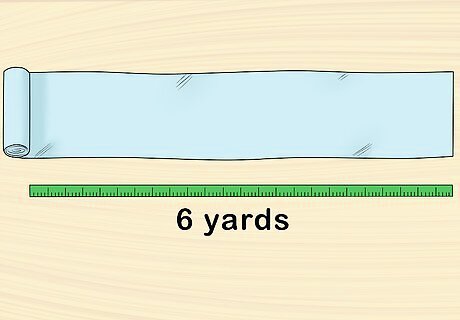
Buy at least 6 yards (5.5 m) of tulle. You will need a lot of tulle to create an overlay or underskirt for your dress whether the dress is long or short. Purchase 6 yards (5.5 m) of tulle fabric in the color of your choice. Try getting some black tulle to layer over a black dress. Or, use a contrasting color with your dress, such as hot pink tulle with a black dress or green tulle with a purple dress. Some types of tulle fabric have glitter or sequins on them. You can also find tulle in different textures, such as a heavy flat tulle, a lightweight airy tulle, or tulle that is crinkled. Opt for a heavier tulle to give your dress some volume and structure. Opt for a lightweight tulle for an airy overlay.

Buy 2.5 yards (2.3 m) of 3 inches (7.6 cm) wide ribbon. You will be sewing a piece of ribbon onto the pleated edge of the tulle. The ribbon will secure the skirt around your waist so you will need enough ribbon to fit all the way around your waist and tie the ribbon in a bow. Look for a piece of ribbon that matches your tulle color or that will at least blend in well. For example, if your tulle is black, get black ribbon. If your tulle is baby blue, then get ribbon that is baby blue or white.
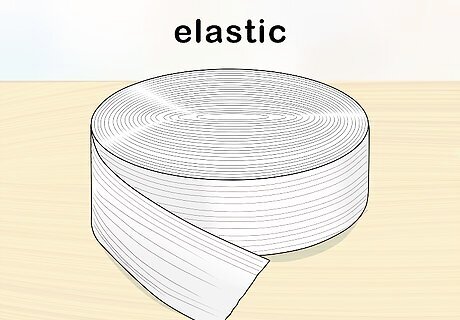
Get enough elastic to fit around your waist. If you prefer to secure the skirt with elastic, then purchase enough elastic to fit around your waist. You can use any color elastic for an underskirt. If you want to make an overlay with an elastic band, then choose an elastic that matches the color of the tulle, or that at least blends in. For example, if the tulle is red and you want to wear it over a black dress, get red elastic if possible. But if you cannot find red elastic, get black elastic so it will blend in with your dress.

Hold the tulle at your waist and mark the tulle with the length you want. Hold the tulle up to your body and bring the longest edge of the tulle so that it is in line with your waist. Then, make a mark where the tulle meets the part of your body that you want it to, such as your knees, mid-calves, or feet. This is where you will need to cut the tulle. It may be difficult to mark the fabric while you are holding it, so you might want to have a friend mark the fabric for you. Before you mark the tulle, add ⁄8 in (1.6 cm) for the waist seam. You might also want to add at least 1–2 in (2.5–5.1 cm) for the hem in case you want to even the hem later.

Fold the tulle and cut a straight line across where you marked it. Fold the tulle widthwise several times so that it is in a bundle. Then, cut a straight line across the marked area of the tulle. Use a sharp pair of scissors or a sharp rotary cutter on a cutting mat to cut the fabric. For a fuller skirt, cut more widths of tulle and sew them together.

Measure and cut the ribbon. To ensure that you have enough ribbon to wrap around your waist and secure the skirt with a bow, wrap the ribbon around your waist twice. Mark the ribbon where you need to cut it and then make the cut.
Pleating and Sewing the Tulle
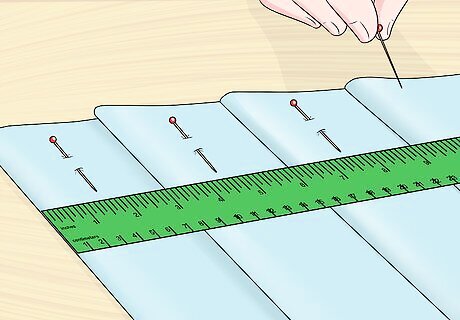
Pleat and pin the edge of the skirt to create 3 in (7.6 cm) pleats. Pleating the tulle fabric will gather it at the waist and make the skirt look full. To pleat the skirt, fan out the fabric and then begin making folds in the fabric that are 3 inches (7.6 cm) wide. Fold the first pleat inwards to hide the raw edge of the tulle, and then fold the rest of the pleats in the opposite direction.

Wrap the pinned tulle around your waist to check the width. After you have pinned all of the pleats, hold the pinned tulle edge up to your waist and wrap it around to check the fit. The pleated tulle should be fitted around your waist with only 2 inches (5.1 cm) to 3 inches (7.6 cm) of slack. This will allow you to sew it onto a piece of ribbon or elastic. If the tulle is too tight, then you will need to release a couple of pleats or go back through and re-pleat the whole piece of fabric with narrower pleats.
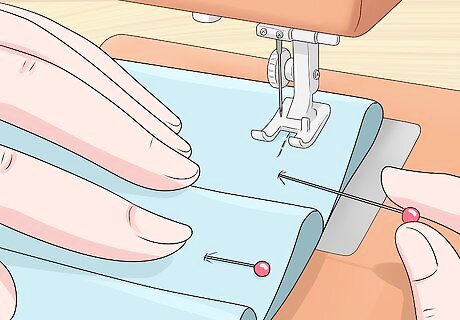
Sew along the pinned edge to secure the pleats. When you are happy with the look of your pleats, sew along the pinned edge to secure them. Use the straight stitch setting on your sewing machine to do this. You can also hand stitch the gathers, if you prefer. Remove the pins as you sew. If you are having trouble sewing the seam, then try placing a piece of folded tissue paper under the edge of the tulle as you sew. This will help you to create the seam and you can rip the tissue paper off when you are finished. You may want to place a piece of tape over the feed dogs at the bottom of your needle to avoid a snag. This will prevent the tulle from getting caught in the gears as you sew.
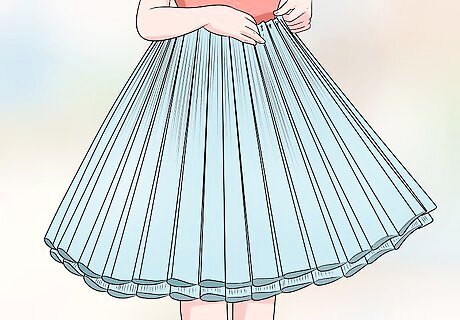
Make additional layers if desired. You may use just 1 layer of tulle for your underskirt or overlay, or you may make multiple layers for a fuller skirt. Make as many additional layers as you like to achieve the desired look. Try making a skirt that has just 1 or 2 layers for an overskirt, and opt for 3 or more layers for an underskirt to give your prom dress a fuller look. Try on the tulle skirts under or over your prom dress as you make them to determine how many layers to use.
Assembling the Tulle Skirt

Sew the tulle layers together with a zigzag stitch. After you have the desired number of tulle layers, sew the layers together along the stitched edges to connect them. A zigzag stitch works best to connect your tulle layers securely. You can also use small hand stitches, if you prefer.
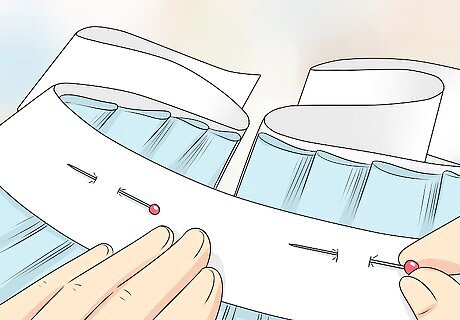
Pin the ribbon onto the pleated edge of the tulle. Line up the ribbon edge with the edge of the tulle on one side and pin along the edge. Make sure that the ribbon overlaps the edge of the tulle by about 0.5 inches (1.3 cm). The ribbon should also have an equal amount of excess on either side of the tulle skirt edge so you will be able to tie the ribbon in a bow.
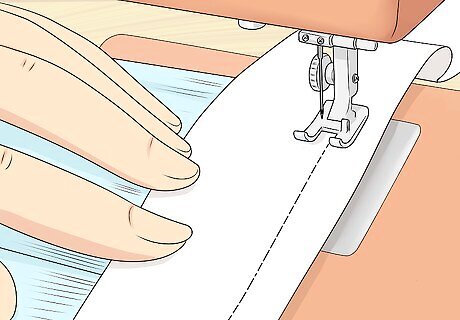
Fold and sew the ribbon onto the tulle edge. Fold the ribbon over to the other side of the tulle and pin along this edge to hide the raw edges of the top of your tulle skirt. Sew along the pinned edge to secure the ribbon. Remove the pins as you go.
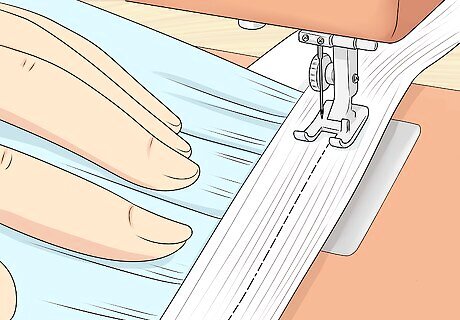
Sew the tulle onto your elastic strip. If you want to secure the tulle skirt with elastic instead of ribbon, line up the elastic and the top edge of the tulle skirt on your sewing machine so that the ends are even. Begin sewing a zigzag stitch down the length of the elastic. Tug the elastic slightly as you sew to ensure that it is the same length as your skirt edge, but do not stretch the elastic beyond the edge of the skirt. Sew all the way to the end of the elastic and tulle skirt. Stitch the ends of the elastic and tulle skirt together to secure them in a circle.

Leave the bottom of the skirt unhemmed. Your skirt is ready to wear after you sew the ribbon into place. You do not need to sew a seam on the bottom of your tulle skirt because tulle does not fray. You can leave it unhemmed and it will be fine.




















Comments
0 comment